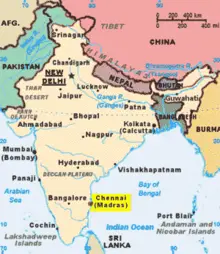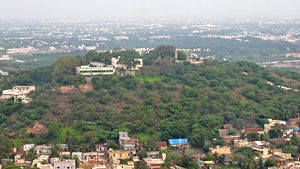St. Thomas Mount
St. Thomas Mount is a small hillock located in Chennai, Tamil Nadu, India near Guindy and close to the flying range in Chennai. It has been associated with St. Thomas, the apostle of Christ, whom legend maintains had been martyred on the spot. The mount is known locally as "Peria Malai" (Big Mount—in Tamil language) or "Parangi Malai." A small relic-filled Church built in 1523 by the Portuguese stands at the summit of the 300 foot high St. Thomas Mount.[1] Pope John Paul II visited the sacred place during his visit to India on February 5, 1986.
Legend
According to legend, St. Thomas had been one of the first Christians to reach India and to preach Christianity.[2] Believed to have reached South India in 52 C.E., spending the last years of his life in a cave on the hill. Tradition states that Thomas had been martyred in 72 C.E., shot of an arrow. Over the centuries, the legend has been passed on, bestowing the name St. Thomas Mount on the hill.
Hill shrine
A shrine dedicated to "Our Lady of Expectation" (Mother Mary had been built in 1523 on top of the mount. The altar stands on the spot believed where legend places St. Thomas martyrdoom in 72 C.E. A gateway stands at the northern foot of the Mount with four impressive arches surmounted by a cross bearing the inscribed date 1547. A flight of 160 steps leads up to the summit of the Mount. Fourteen stations of the cross have been erected on the way to the summit.
In 1547, an excavation unearthed a stone cross with old Sassanid Pahlavi inscriptions on it. The cross, reputed to have been chiseled by the Apostle himself, became known as the 'Bleeding Cross' as it has stains resembling blood stains which reappear even after being scrubbed off. It is also supposed to 'bleed' afresh periodically. It first 'bled' publicly during Mass in 1558 and the last record occasion when it 'bled' was in 1704. Fr. Guy Tachard, a Roman Catholic priest has recorded about this as explained by then Vicar, Fr. Gasper Coelho. St. Thomas is supposed to have clutched this cross as he lay dying.
When it was discovered, the cross was built into the wall being the altar of the church, which it adorns even today. On either side of the chancel there are framed oil paintings depicting the twelve Apostles of Jesus Christ. Above the altar is an oil painting of The Madonna, which is believed to be one of the seven painted by St. Luke the Evangelist and brought to India by St. Thomas. This picture of the Madonna is considered to be the oldest Christian painting in India.[3]
The shrine administration is in the hands of the newly formed Catholic (Latin rite) diocese of Chingelpet.
The Festival of Our Lady of Expectation is celebrated on 18th December in a grand manner. Saint Thomas day is celebrated on the 3rd of July in memory of his martyrdom.
During the Easter season, faithful climb the steps to the church, singing hymns and saying the "Way of the Cross" prayers. Petrus Woskan, an Armenian merchant paved the way with granite steps in order to make the climbing easy. It is also said that the oil paintings and beautifully carved Pulpit are also from the same Armenian benefactor.
Adjoining the church, is the convent of the "Holy Apostles Convent," managed by the priests of the Franciscan Missionaries of Mary (FMM) order. Attached to this there is a home for the physically and mentally challenged children run by the nuns of the convent.
Little Mount
The Little Mount (locally known as the Chinnamalai—the small mount), is a rocky prominence where the Apostle is believed to have chosen a tiny cave as his home and led a spartan life, often praying on the top of the hill and preaching to the crowds.[4] Today, this rock-hewn with its low, narrow opening an altar with the image of St. Thomas prayer home. To the east of this cave is an opening, supposedly that of a tunnel through which the Apostle fled from his assailants to St. Thomas Mount. The faithful believe that the opening (window) was miraculously made and through this St. Thomas escaped from his enemies who were waiting in front of the entrance. Near the tunnel's entrance is a clearly visible palm print. This hand-print and the footprint at the foot of the hillock, are believed to be those of St. Thomas himself.
Little Mount has an ancient church built by the Portuguese in 1551. At the entrance is a portrait of St. Thomas and Portuguese inscription, while a masonry cross at the top of the hill marks the spot where St. Thomas customarily preached.
St. Thomas Garrison Church
St. Thomas Garrison Church is a 175 years old Church located at the foothills of the Mount. Built by the British it is a magnificient Church.
St. Thomas Sand
St. Thomas Sand is the sand taken from the tomb of St. Thomas at Mylapore, in Chennai, India. The sand from the tomb is considered a relic of the Apostle, and the faithful believe that it has miraculous healing powers. They procure small quantities of sand and either carry it with them or keep it in their homes. The belief is a long-standing one, for Marco Polo mentioned the custom in his travel records.[5]
St. Thomas Postage Stamps
In 1972, to commemorate the nineteenth centenary of the martyrdom, the Government of India Department of Post and Telegraphs released a postage stamp depicting the picture of the bleeding cross of St. Thomas Mount. Earlier, in 1964, the Post and Telegraph department of India had released a stamp depicting the Ortona silver bust of St. Thomas located in Italy.
Gallery
- St. Thomas Mount Church.jpg
St. Thomas Mount Church altar where legend locates St. Thomas' martyrdom.
- St. Thomas Mount Church sanctuary.jpg
Altar of St. Thomas Mount Church from further back in the sanctuary.
See Also
- Saint Thomas (the Apostle)
- Saint Thomas Christians
- Christianity in India
- Portuguese India
- Religion in India
Notes
- ↑ Martin Goodman. 2002. On sacred mountains (Loughborough: Heart of Albion), p. 72.
- ↑ Edward Gibbon, Henry Hart Milman, and Guizot. 1880. The history of the decline and fall of the Roman empire (Philadelphia: Nottingham Society), v. 4, pp. 694-695.
- ↑ H. Hosten. 1936. Antiquities from San Thomé and Mylapore, [the traditional site of the martyrdom and tomb of St. Thomas, the Apostle] (Madras: Diocese of Mylapore).
- ↑ Lonely Planet Publications (Firm), and Sarina Singh. 2003. India (Footscray, Vic: Lonely Planet), p. 694.
- ↑ Marco Polo, Henry Yule, Amy Frances Yule, and Henri Cordier. 1993. The Book of Ser Marco Polo, the Venetian, concerning the kingdoms and marvels of the East (New Delhi: Munshiram Manoharlal Pub.)
ReferencesISBN links support NWE through referral fees
- Gibbon, Edward, Henry Hart Milman, and Guizot. 1880. The history of the decline and fall of the Roman empire. Philadelphia: Nottingham Society. OCLC 7346817.
- Goodman, Martin. 2002. On sacred mountains. Loughborough: Heart of Albion. ISBN 9781872883588.
- Hosten, H. 1936. Antiquities from San Thomé and Mylapore, [the traditional site of the martyrdom and tomb of St. Thomas, the Apostle]. Madras: Diocese of Mylapore.
- Lonely Planet Publications (Firm), and Sarina Singh. 2003. India. Footscray, Vic: Lonely Planet. ISBN 9781740594219.
- Polo, Marco, Henry Yule, Amy Frances Yule, and Henri Cordier. 1993. The Book of Ser Marco Polo, the Venetian, concerning the kingdoms and marvels of the East. New Delhi: Munshiram Manoharlal Pub. ISBN 9788121506021. OCLC 2525456.
External links
- Catholic encyclopedia. Retrieved September 4, 2008.
- Encyclopedia Britannica. Retrieved September 4, 2008.
- Website of St.Thomas Basilica. Retrieved September 4, 2008.
- Little Mount. Retrieved September 4, 2008.
- History of St. Thomas in India. Retrieved September 4, 2008.
- A short history of St. Thomas. Retrieved September 4, 2008.
- University of Chicago photo library. Retrieved September 4, 2008.
- Little Mount. Retrieved September 4, 2008.
- The Myth of St. Thomas in India. Retrieved September 4, 2008.
Template:Chennai - Suburban Railway,South
Credits
New World Encyclopedia writers and editors rewrote and completed the Wikipedia article in accordance with New World Encyclopedia standards. This article abides by terms of the Creative Commons CC-by-sa 3.0 License (CC-by-sa), which may be used and disseminated with proper attribution. Credit is due under the terms of this license that can reference both the New World Encyclopedia contributors and the selfless volunteer contributors of the Wikimedia Foundation. To cite this article click here for a list of acceptable citing formats.The history of earlier contributions by wikipedians is accessible to researchers here:
The history of this article since it was imported to New World Encyclopedia:
Note: Some restrictions may apply to use of individual images which are separately licensed.


